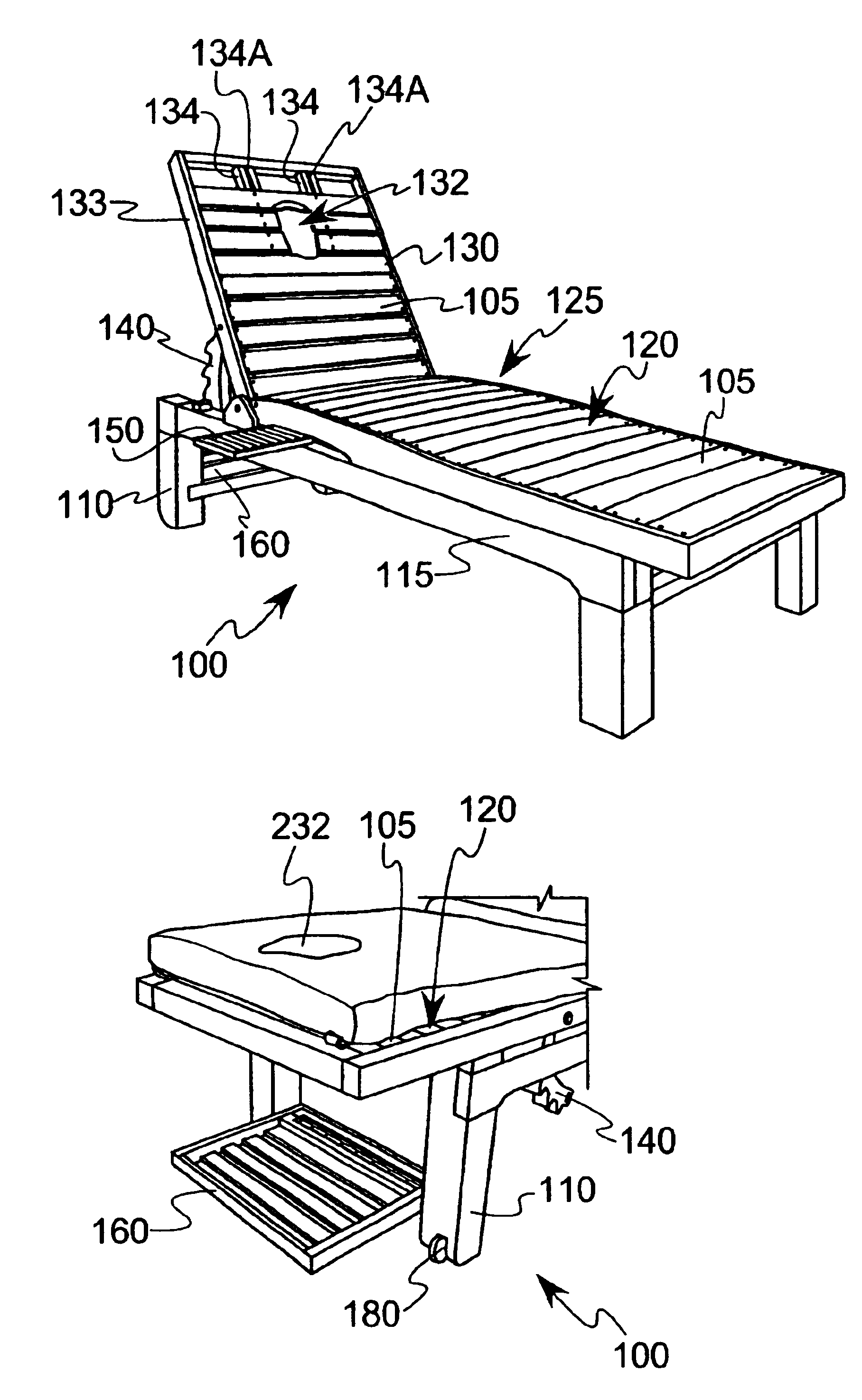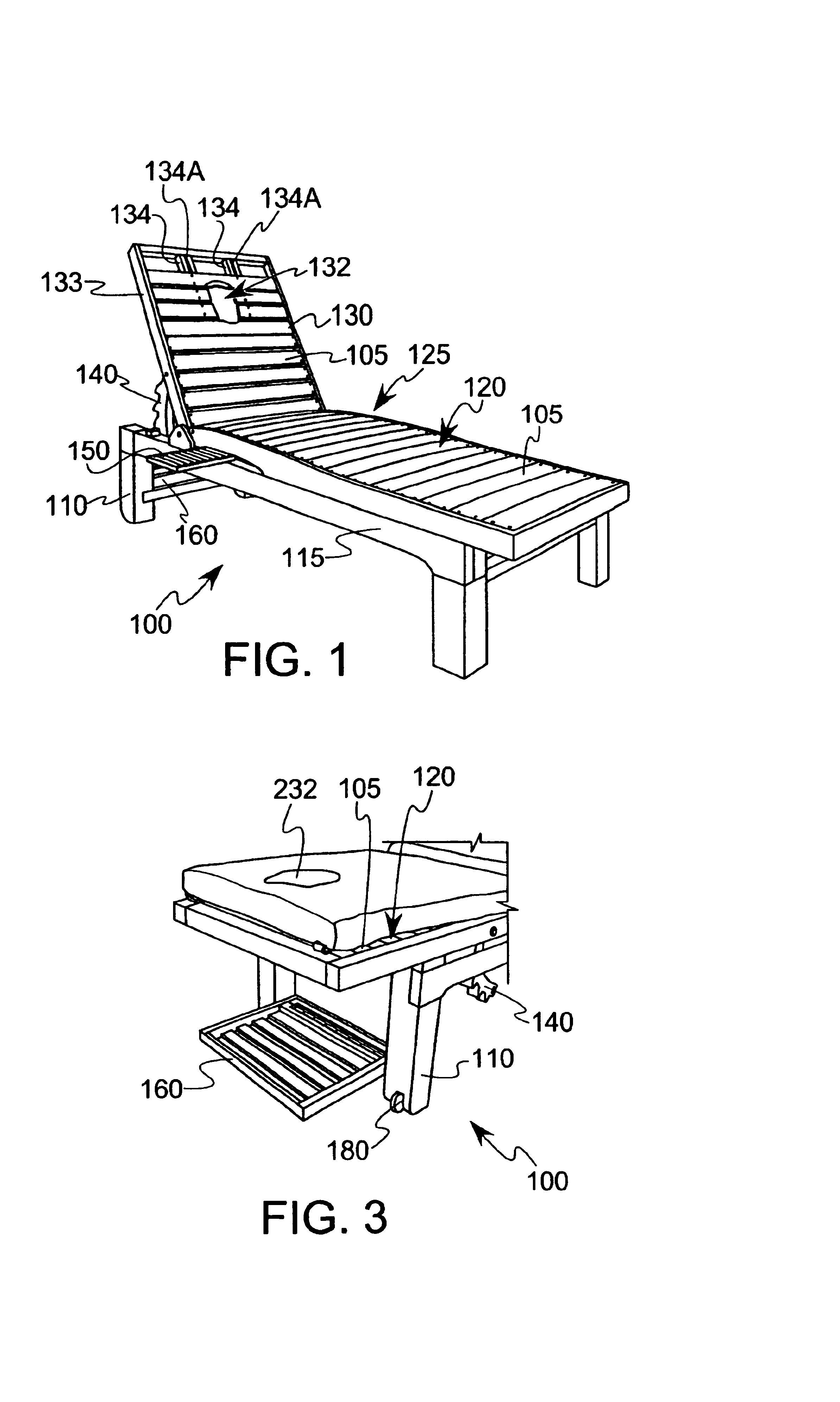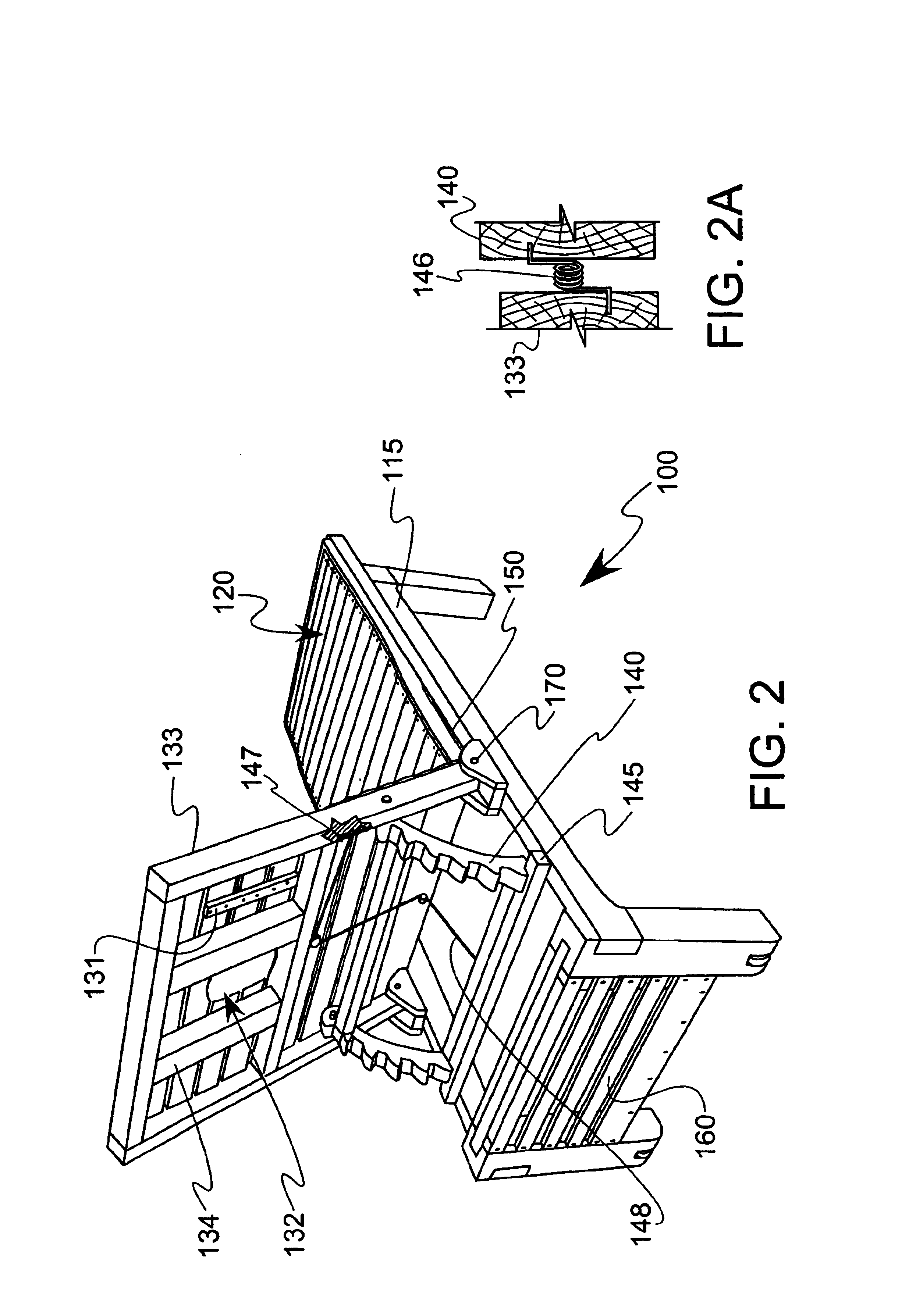The present invention satisfies these needs by providing an orthopedic lounge chair which is very rugged and durable in its construction, yet easy to operate. According to a first aspect of the present invention, a lounge chair includes a frame, seat section, back section and hinge section to pivotally couple the back and seat sections. The back and seat sections define upper surfaces for engaging a user, where the seat section defines an orthopedic upper surface. In the present context, a surface is considered orthopedic if it includes
contouring or shaping that provides enhanced support to a body portion, such as ventral or dorsal regions in the
torso. The hinge section includes an
actuator responsive to
user input, an angle adjustment mechanism responsive to the
actuator, and a biasing member to promote the selective engagement of the angle adjustment member to at least one of the back and frame sections. The biasing member maintains the aforementioned engagement until overcome by deployment of said actuator, which forces disengagement of the cooperative components. During this disengaged period, a plurality of angular positions between the back and seat sections is possible.
Optionally, the orthopedic upper surface of the seat section chair has a fixed convex (upwardly bowed) arch to provide the enhanced support. For example, additional
lumbar support is available to a user lying prone on the chair. In this configuration, the arch support gently pushes upward on the hips of the user, straightening out the natural curvature of the
lumbar section of the spine. This position relaxes the lumbar and avoids the uncomfortable
hyperextension experienced by conventional lounge chairs. In another option, the chair is constructed predominantly from rigid materials, such as wood, where the wood is preferably
hardwood, such as ipe, teak or oak. It will be appreciated by those skilled in the art that other materials, such as high quality plastic resin, stainless steel, or the like could be used. In the present context, construction of a component that is “predominantly” from a particular material does not necessitate that the entirety of the component be made from that material, just that a majority of it be so. In such case, ancillary materials, such as
metal or plastic for connectors, fasteners or particular portions of the component, can be used to facilitate proper functioning or
assembly of the component. In addition, the rigid nature of the construction enables the orthopedic upper surface to be integrally formed into the seat section.
In another option, the head aperture formed into the back section is adjustable to allow different size users to maintain optimum orthopedic positioning. The head aperture eliminates the need of the user to rotate the neck while lying prone, thus eliminating the undue stress to the upper neck and back, and allows the upper
cervical spine to maintain alignment, avoiding uncomfortable
hyperextension or lateral rotational stress in the upper back and neck. Since the upper surface of the back section is rigid, the aperture (which can be formed by a plurality of discreet slats that are each slidably mounted to longitudinal support members in the back section) can be varied by moving one or more of the slats up or down the back section support members. In one form, the back section support members may define a plurality of rails that can be slotted to engage complementary surfaces in the slats making up the head aperture. In the present context, the longitudinal dimension of the chair is the one along the chair's generally elongate (i.e., head-to-foot) direction. Moreover, the numerous slats making up the aperture can be coupled together so that they move in
unison.
In addition, at least the seat section can be tapered across the narrow (side-to-side) dimension to provide rigid support rather than the scoop or concavity experienced in the seat and back sections of conventional lounge chairs. Such a taper would allow the lateral (side) edges of the seat section to be lower than the central portion of the seat section. By being formed of the aforementioned rigid materials (such as wood or the like) and not relying on straps or fabric that stretch further downward under the applied weight of a user, the chair is easy to get into and out of.
In another option, the biasing member is a spring-loaded mechanism that allows the user to adjust the seatback to the desired angle without having to reach under the seat to set adjust the member (also referred to as the catch) on the frame or back section that engages the angle adjustment mechanism, which can be in the form of a generally semicircular wheel with splines formed therein. These splines can be made to selectively engage a complementary catch that is rigidly affixed to the frame by operating the actuator. In one form, the actuator is a release
handle placed in such a location as to be easily graspable by the user. For example, the actuator is disposed on the back section and is responsive to single-hand input such that the angular position between the seat and back sections can be adjusted while the user is on the lounge chair by having the user grasp the actuator and the back section simultaneously. This allows the user to then lower the back section with one hand while seated, not having to reach under the back section to adjust the angle adjustment mechanism that selectively engages the catch. The tight tolerance between the frame of the chair and the back section minimizes the risk of pinching the user's hand when the back section is fully reclined to substantially flat position. In the present context, the term “substantially” is utilized to represent the inherent degree of uncertainty that may be attributed to any quantitative comparison, value, measurement, or other representation. As such, it refers to an arrangement of elements or features that, while in theory would be expected to exhibit exact correspondence or behavior, may in practice embody something slightly less than exact. The term also represents the degree by which a quantitative representation may vary from a stated reference without resulting in a change in the basic function of the
subject matter at issue. The spring-loaded nature of the biasing member assures the catch is fully engaged with the angle adjustment mechanism, thereby promoting safety by preventing a partially engaged angle adjustment member from slipping off the catch and causing collapse of the back section. By being spring-loaded, the user only needs to simply
pull up on the seatback to the desired angle and the notched catch will automatically engage. To lower the back section, the user simply squeezes the
handle which releases the angle adjustment member from the catch, thereby allowing the user to lower the back section to the desired position. This one-handed operation is possessive of an inherit safety element, where the user is simultaneously grasping the seatback and the release
handle, causing the user to hold on to the seatback, not allowing it to inadvertently collapse down onto the frame.
Other options include a fold-down
magazine rack situated below the head aperture, thus allowing the user to read while lying prone and maintaining optimum orthopedic positioning. One or more additional pull-out trays may be built into the frame for beverages, books and related personal possessions. Wheels can be incorporated into some or all of the legs to allow the user easy means to relocate the chair by simply lifting one end and wheeling the chair to a new location. Attachable cushions with a matching face opening can be strapped over the seat and back sections, and can be tied together or fastened with velcro or the like.
 Login to View More
Login to View More  Login to View More
Login to View More 


